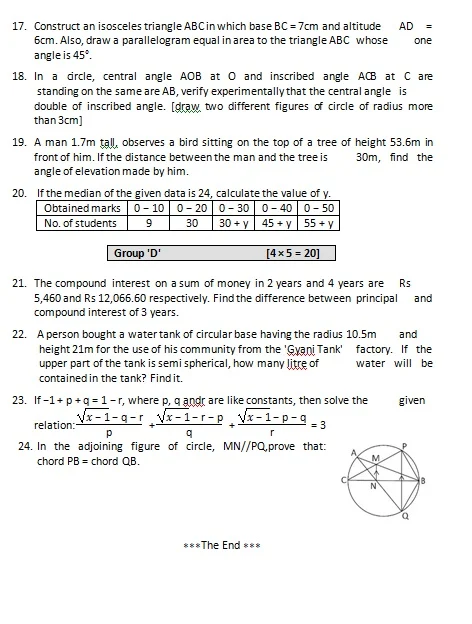d) What type of combination of cells is shown in the given circuit? Calculate the power of the bulb if 0.2Acurrent flows through the curcuit.

Answer the following questions:
a) What is ment by one kilowatt hour in electricity?
Ans: The electricity consumed by electric load of load of one kilowatt power in one hour is known as one kilowatt hour in electricity.
b) What is meant by electric current?
Ans: The flow of electron in a conducting wire is known as electric current.
c) What is meant by electric circuit?
Ans: The pathway of electricity containing combination of source, load and switch is known as electricity circuit.
d) What is meant by electricity consumption?
Ans: The amount of electricity which id converted to the other forms of energy by using load is known as electricity consumption.
e) How is electricity consumption calcutated?
Ans: To claculate the electricity consumption the product of the number of load, power, and time is calculated:
Electricity consumption= P×N×T
f) What is meant by electric power?
Ans: The amount of electric of energy consumd by a load in one second is known as electric power.
g) Which instrument is used to measure the electrical power consumption?
Ans: Meter box is used to measure the electrical power consumption. It measures the power consumption in kilowatt hour.
h) What is meant by galvanometer?
Ans: The electrical device which is used to measure small signals of current is known as galvanometer.
i) On which principle generator and dynamo depends?
Ans: The working principle of generator and dynamo depends on the principle of electromagnetic induction.
j) What are the types of generator?
Ans: Following are the types of generator:
i. AC generator
ii. DC generator, etc.
Give reasons:
a) The efficiency of a transformer is never 100%, why?
Ans: There is resistance in the coil of a transformer, so the efficiency of a transformer is never 100%.
b) Soft iron armature is used in electric bell, why?
Ans: The more the metal is soft the strength of magnet formed is more. So, soft iron armature is used in electric bell.
c) Filament lamp is filled with inert gases. Why?
Ans: In high temperature i.e. around 2900°C tungsten filament can get oxidised due to reaction with oxygen. So, to prevent oxidation and maintain the pressure, innert gas is filled in filament lamp.
d) Why is Nichrome used in heater?
Ans: Nichrome has high resistance and does not get oxidised even in high temperature like 900°C and can easily converts electric energy into heat energy. So, nichromee is used in heater.
e) Why should the coil of transformer be laminated?
Ans: When curent flows through the coil of transformer, eddy current is produced in the core. If the coil of transformer becomes a single piece, the amount of eddy current increases and the transformer gets heated and damaged. Output is also low. So, the coil of transformer is laminated.
Differentiate between:
a) Phase wire and Neutral wire
Ans: Following are the differentiate between on phase and neutral wire:
| Phase wire | Neutral wire |
|---|
| It is a red/ brown colored wire connected electrical device (load) to input current. | It is a black or blue colored wire through which current from load returns back. |
| We feel electric on touching it. | We feel electric on touching it. |
Numerical problems:
i. Power consumption (pc): Power (P) × Hour(H)
=Watt × Hours
= KWH
=Unit
ii. Watt = Volt × Amper
Power = Volt (V) × current (Amper)
According to ohm’s law:
V = IR
PD = Current × Resistance
Volt Amper ohm (Ω)
a) An electric kettle rated 220 V and 2.2 KW works for 3 hours. Find the energy consumption and current drawn by it.
Given data,
PD = 220 volt
Power= 2.2 kw
Time = 3 hours
We know that,
Power consumption= power × hour
= 2.2kw × 3 hour
=6.6 KWH
= 6.6 Unit
Again, current drawn (I)= ?
P=VI
∴ I = P/V = 2.2 × 100W/ 220 = 2200/220
=10 AMP
∴The energy consumption is 6.6 unit and current drawn by it is 10 AMP.
b) If a 1000W heater is to be operated at a 220V mains, what must be the rating of the force to be used in the circuit?
Given data,
P = 1000 W
PD= 220V
Fuse (I)= ?
We know that,
P =VI
∴I = P/V= 1000/220
=50/11 = 4.5 = 5AMP
∴So the 5AMP is the rating of the force to be used in the circuit.
c) If two irons of 750W each are used 8hours a month. How much tariff should be paid? Cost of one unit of electricity is Rs 7.
Given data,
P= 750W
T=2 month
N= 8 hours
We know that,
Power consumption= 750 × 8 × 2
= 2 × 750 × 8/ 1000
= 12 KHW
=2 unit
∴ The cost of 1 unit= Rs. 7.00
∴The cost of 12 unit = 12×7 = Rs. 84.00
d) What type of combination of cells is shown in the given circuit? Calculate the power of the bulb if 0.2Acurrent flows through the curcuit.
Given data,
Amp= 0.2
Volt = 6
We know that,
Watt= Volt × Amp
= 6×0.2
=1.2 watt
e) In a transformer, the number of turns in primary coil is 100. If the primary and secondary voltage are 220V and 110V respecctively, calculate the no of turns in the secondary coil.
Given data,
Np= 100
Vp= 220 volt
Vs= 110 volt
Ns=?
we know that,





















